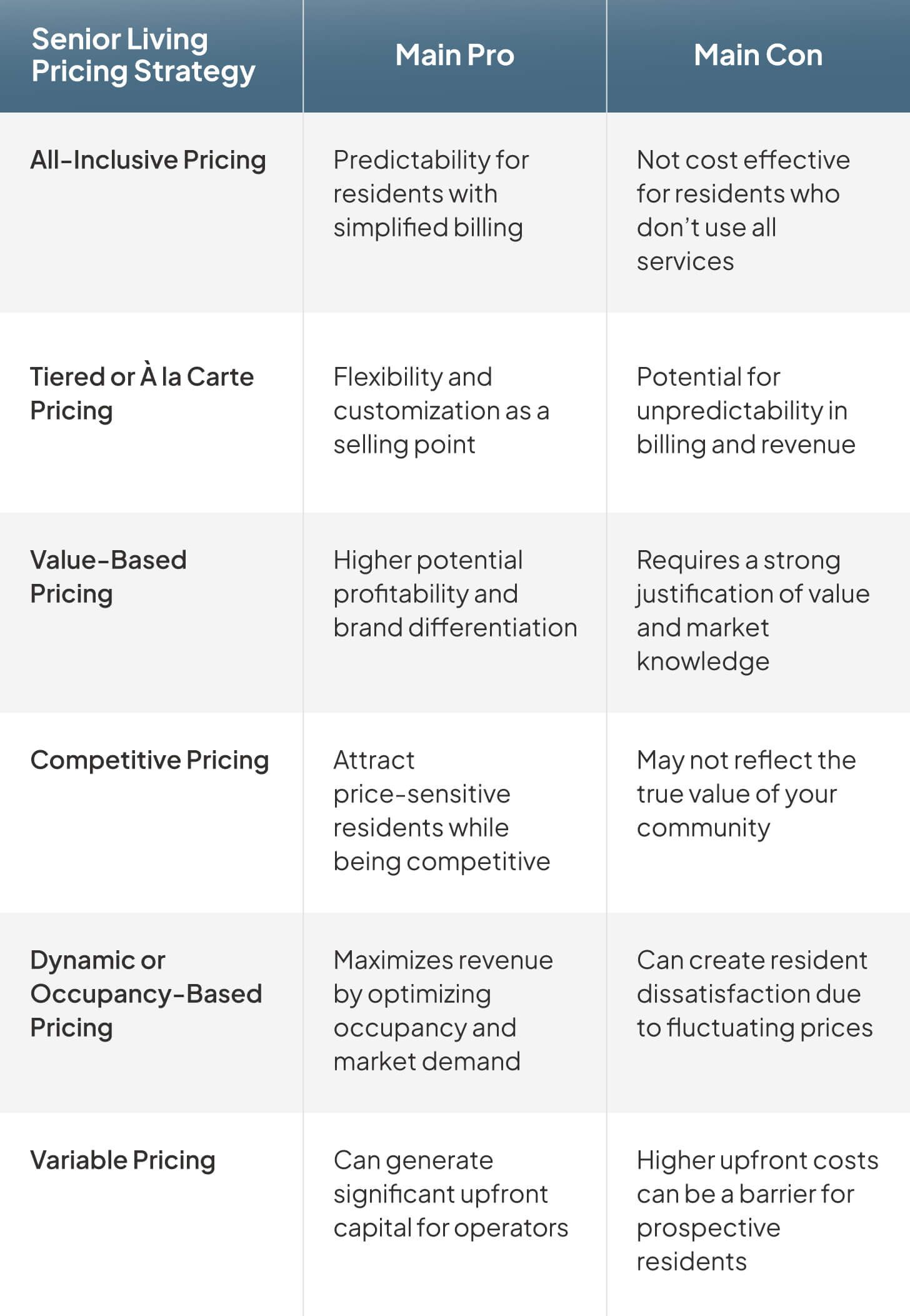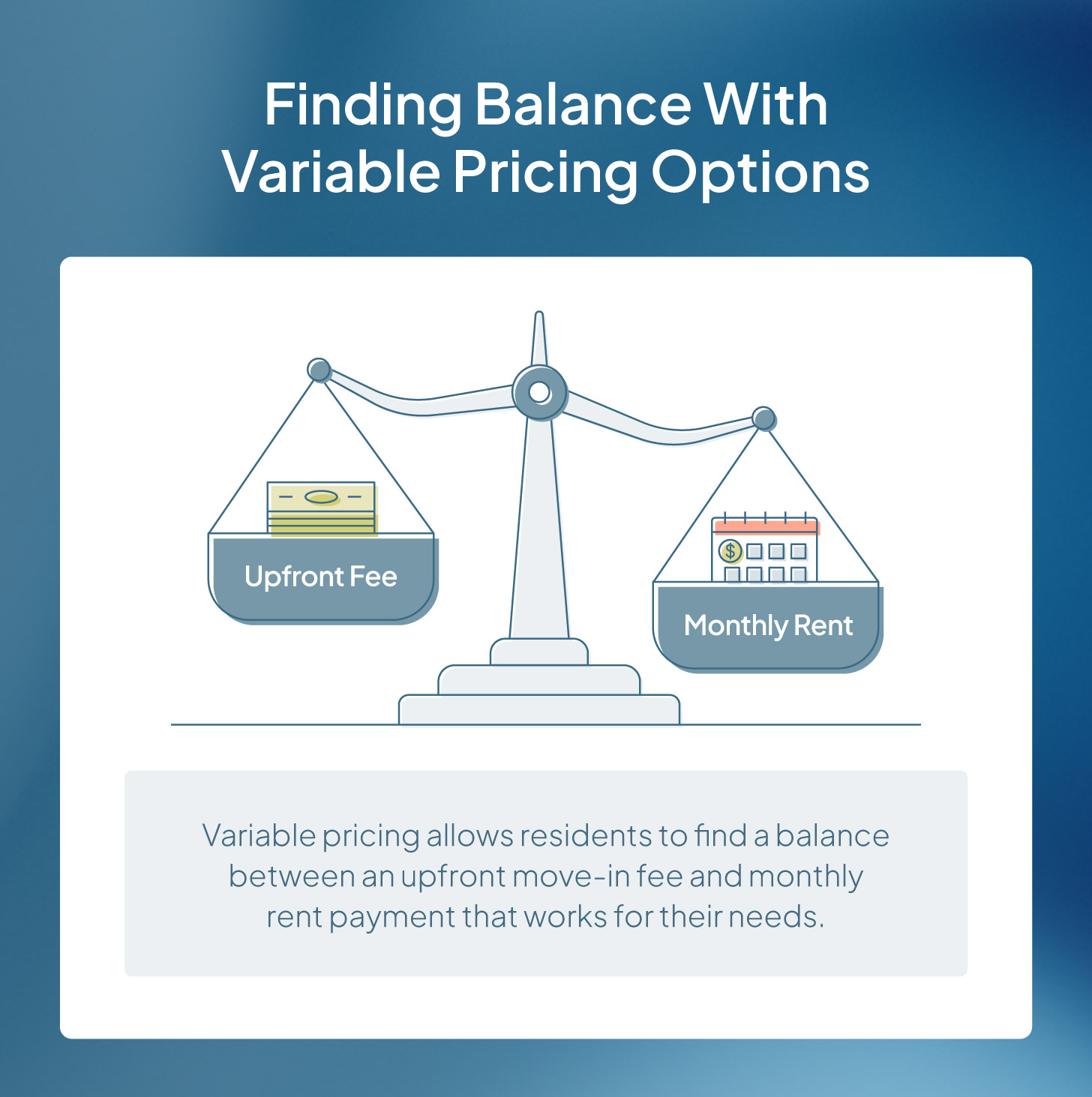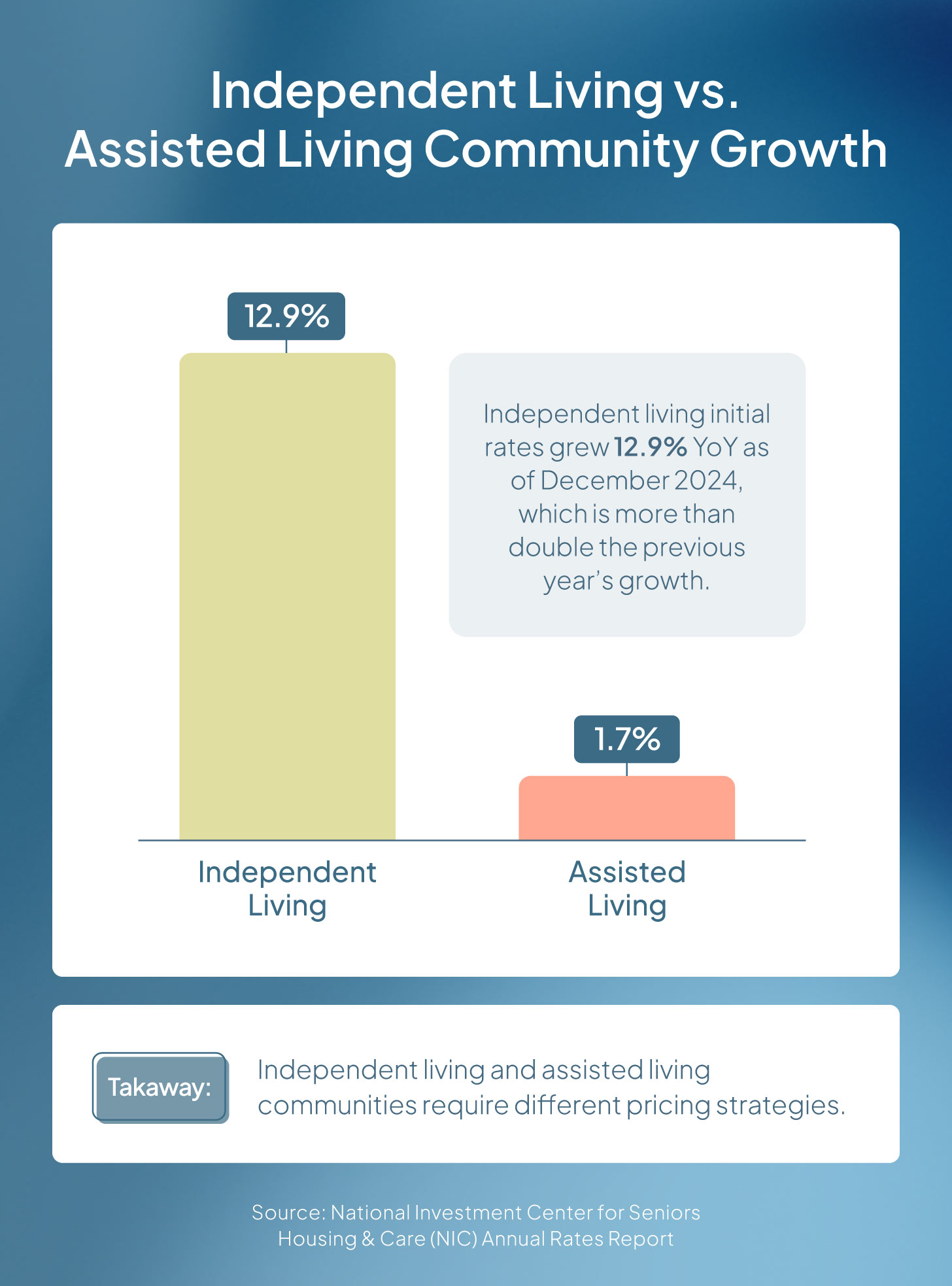Optimizing Senior Living Pricing Strategies: An Operator’s Guide
Gain insight into senior living pricing strategies for community success. Explore how Aline’s software optimizes revenue and operations

Gain insight into senior living pricing strategies for community success. Explore how Aline’s software optimizes revenue and operations
Published on: August 27, 2025
Last updated: September 11, 2025

With rising demand, today’s senior living operators face growing complexities and competition, highlighting the need to balance excellence in care with financial viability. Effective senior living pricing strategies must go beyond maximizing revenue to include maintaining healthy occupancy rates, enhancing resident satisfaction, and ensuring long-term sustainability.
While operators are well aware of these challenges — with 61% in our 2025 State of Senior Living Report indicating they’re actively adjusting pricing or service offerings to strike the right balance between affordability and profitability — success hinges on understanding the full range of senior living pricing strategies available. By evaluating the benefits and trade-offs of each method, operators can make informed decisions that align with their community’s goals and position them for sustainable growth.
Choosing the right approach to pricing is one of the most important decisions an operator can make. The right strategy can strengthen revenue, maintain occupancy, and support resident satisfaction. Below are six common senior living pricing strategies, each with its own advantages, challenges, and best-fit scenarios for different community needs.

All-inclusive pricing simplifies senior living costs by offering residents one consistent, flat monthly charge that covers nearly all services and amenities the community provides. This often includes accommodations, meals, personal care services, utilities, housekeeping, transportation, and social activities.
For residents and families, this model offers clarity and peace of mind. All charges are known upfront, making budgeting straightforward. For operators, it streamlines billing, reduces administrative complexity, and supports more accurate revenue projections.
Pros:
Cons:
Tiered or à la carte pricing offers a configurable approach that allows residents to customize their senior living experience. With this model, residents pay a base rate for accommodations — typically covering housing, basic utilities, and access to shared spaces and activities — and then select and pay for additional services as needed.
This model resonates with residents and families who prioritize flexibility, allowing them to tailor services to fit both their lifestyle preferences and financial resources. For operators, tiered or à la carte pricing provides flexibility in service delivery and can attract a broader spectrum of residents, especially in life plan communities where needs may change over time.
Pros:
Cons:
Value-based pricing goes beyond simply covering costs for a list of services. Instead, it sets prices according to the perceived value residents and their families place on the unique combination of services, amenities, and lifestyle a community provides. Operators using this strategy must differentiate their community through exceptional care, distinctive programs, a prime location, or other standout features.
This approach requires a deep understanding of the target market — including resident preferences, willingness to pay, and how the community outshines its competitors. When executed well, it enables operators to command higher prices by delivering a distinctive resident experience that justifies the premium.
Pros:
Cons:
Among senior living pricing strategies, competitive pricing sets rates by benchmarking against local competitors rather than relying primarily on internal costs. The emphasis is on market positioning—how your community compares to nearby options—so operators need regular, structured market checks via a CRM and other market-intelligence methods to keep pricing current.
Most common in mature, highly competitive markets, this approach allows families to compare many communities side by side. While it makes it easier to communicate where you stand on price, it also introduces ongoing administrative effort and the risk of overfocusing on cost.
Pros:
Cons:
Dynamic or occupancy-based pricing gives operators the flexibility to adjust rates in near real time based on occupancy, demand, seasonality, and local market conditions. The approach resembles yield management in hotels or airlines: Discounts or incentives can stimulate move-ins during soft periods while higher-demand periods support firmer or increased pricing to optimize revenue.
For senior living communities, this senior living pricing strategy enables rapid responses to market signals with the aim of balancing high occupancy and strong revenue. Effective execution depends on robust analytics to track key metrics and inform timely adjustments.
Pros:
Cons:
Variable pricing gives residents a choice between an upfront entrance, or move-in, fee and their ongoing monthly rate, much like paying points on a mortgage. Residents can opt to pay a higher entrance fee for a lower monthly rate or choose a lower entrance fee in exchange for a higher monthly rate.
Among pricing strategies, this approach emphasizes flexibility but requires clear, transparent communication, so residents and families fully understand the trade-offs and any refund provisions. For operators, it can also strengthen near-term cash flow.

Pros:
Cons:

In our 2025 State of Senior Living Report, operators ranked competition and price pressure among their top five challenges. Choosing a pricing strategy is only half the challenge; disciplined execution is what protects margins, occupancy, and trust. Keep the following in mind.
In a complex and competitive market, automation is essential to managing intricate senior living pricing strategies. Aline Leasing & Billing software centralizes rate plans and automates key workflows, so operators can apply pricing decisions consistently, reduce manual work, and connect billing directly to care and service changes.
By capturing every service and care change in real time, the system reduces missed revenue and administrative rework. Accurate, on-time statements help plug common leaks, like unbilled services or delayed charges, so cash flow and forecasting are more reliable.
Because charges flow directly from care assessments, service authorizations, and rate plans, every line item is easy to explain. That transparency reduces billing disputes, shortens DSO, and builds trust with families while giving operators an auditable record to apply pricing rules consistently across all models.
Aline Leasing & Billing includes built-in analytics that turn raw data into actionable insight, covering real-time occupancy trends, move-in and move-out patterns, vacancy by unit type, pipeline velocity, rate-plan performance, and more.
Dashboards and customizable reports put this information at your fingertips, providing clear visibility into your community’s financial and operational health whenever you need it.
With these insights, operators can make smarter pricing decisions, such as identifying which senior living pricing strategies perform best by segment, spotting underutilized services, detecting patterns in resident preferences that suggest new bundles or tier adjustments, forecasting demand to time promotions, and setting floor and ceiling rates with confidence.
Residents and families benefit from clear, plain-language statements and predictable billing through Aline Leasing & Billing, making financial interactions simpler and more transparent. For operators, that clarity reduces friction with fewer disputes, shorter DSO, and less time spent on back-and-forth. so staff can focus on meaningful engagement instead of resolving billing issues. The result is higher satisfaction and trust, stronger reviews and word-of-mouth referrals, longer length of stay, and a tighter sense of community — all essential drivers of long-term success in a competitive market.
Compliance and accuracy are built into the platform from the ground up. Aline Leasing & Billing tracks state and federal requirements, supports compliant documentation for care-level changes, service authorizations, and billing practices, and applies updates as regulations evolve.
Automated workflows calculate, apply, and record every charge according to approved rate plans, effective dates, and proration rules — keeping financial data aligned with resident assessments and care plans. Complex responsibility splits are handled cleanly, including coordination with health care payors, so amounts owed by all parties are visible in a single, reliable view.
For operators, the result is lower audit and penalty risk as well as faster regulatory reviews. Comprehensive audit trails and compliance-ready reports streamline payer reconciliations and save significant administrative time.
Pricing touches resident trust, occupancy, and cash flow. Even with a solid framework, operators still face day-to-day choices — where to set rates, how to connect pricing to billing, and how to prevent revenue leaks. The questions below address the practical side of senior living pricing strategies, helping you move from strategy to confident execution.
Start by triangulating around three anchors: value, market, and unit economics. Price to the experience you deliver, including care quality, programs, location, and outcomes, and then cross-check against your local competitive set to confirm positioning. Finally, model your unit economics to ensure sustainable margins after staffing, care, utilities, technology, and reserves.
Use analytics from Aline Leasing & Billing to test price elasticity, set floor and ceiling rates, and schedule quarterly reviews, so pricing stays aligned with demand and acuity.
A modern platform closes gaps across the revenue cycle. Aline Leasing & Billing automates charge capture, including mid-month care changes; enforces rate plans; handles proration; and generates on-time, accurate statements to reduce underbilling, delays, and write-offs. Transparent invoices and streamlined collections improve cash flow and shorten DSO.
Implementation is designed to be low-disruption. Aline Leasing & Billing connects with your existing systems and hardware, supports data migration, and offers a collaborative rollout — configuration, testing, training, and go-live — so operators can realize value quickly without pausing day-to-day operations.
Without a centralized, automated system, communities miss billable services, apply discounts incorrectly, delay invoices, and rely on error-prone manual entry—especially in tiered or à la carte models.
Revenue leakage compounds over time, straining cash flow, suppressing profitability, and limiting reinvestment in resident care and community improvements.
You’ve explored all-inclusive, tiered/à la carte, value-based, competitive, dynamic, and variable pricing. Now make those choices show up accurately on the bill — and in cash flow.
In “Maximize Your Revenue: Smarter Workflows for Senior Living Operators,” you’ll see how to:


Amanda McGrory-Dixon
Amanda McGrory-Dixon is the content marketing manager at Aline, where she shares expert insights on how senior living communities can streamline operations, enhance resident satisfaction, and drive sustainable growth. With a deep understanding of industry trends and technology, she helps operators navigate challenges and implement data-driven strategies to improve efficiency, profitability, and care outcomes.
Blogs, stories and studies from the forefront of senior living operations

Lead generation surveys give senior living operators the data they need to understand their market, uncover new opportunities, and drive occupancy growth.

Prospect-centered selling helps senior living operators convert more leads and achieve occupancy goals through a more personalized, empathetic approach.

Overcome the biggest senior living financial challenges, including operational costs and occupancy rates, with interconnected software

Take a look at how senior living software options, like Aline, can elevate operations, resident care, and ROI

Enhance efficiency, accuracy, and resident satisfaction by integrating a POS system into your senior living dining operations

See how emerging dining strategies help senior living communities streamline operations while fostering stronger connections with residents
We’re using cookies on this site to improve your experience. Cookies help us learn how you interact with our website, and remember you when you come back so we can tailor it to your interests.
You can find out more about cookies and usage on our cookie policy page.
Some of these cookies are essential, while others help us to improve your experience by providing insights into how the site is being used.
For more detailed information on the cookies we use, please check our privacy policy
Your experience is important to us. We’re redirecting you to our new Aline website, where you’ll discover how our complete suite of senior living solutions can help you grow occupancy and revenue, optimize operations, and enhance resident care.
For more information, you’re welcome to read our statement on our merger. To continue your web experience, simply close this notification.
Your experience is important to us. We’re redirecting you to our new Aline website, where you’ll discover how our complete suite of senior living solutions can help you grow occupancy and revenue, optimize operations, and enhance resident care.
For more information, you’re welcome to read our statement on our merger. To continue your web experience, simply close this notification.
Your experience is important to us. We’re redirecting you to our new Aline website, where you’ll discover how our complete suite of senior living solutions can help you grow occupancy and revenue, optimize operations, and enhance resident care.
For more information, you’re welcome to read our statement on our merger. To continue your web experience, simply close this notification.
Your experience is important to us. We’re redirecting you to our new Aline website, where you’ll discover how our complete suite of senior living solutions can help you grow occupancy and revenue, optimize operations, and enhance resident care.
For more information, you’re welcome to read our statement on our merger. To continue your web experience, simply close this notification.
Aline Innovation Summit 2026: Registration Now Open!
Connect with senior living leaders, innovators, and industry peers May 11-13, 2026, in Frisco, TX to explore the latest innovations, proven strategies, and best practices shaping the future of senior living. View details and register today.